Why is Guangnan Confucius Temple So Special?
Guangnan Confucius Temple广南文庙 was built in 1709(the 48th year of Kangxi period康熙年间 in Qing Dynasty) as a place for worshiping Confucius in Guangnan County. It is located in Chengnan Street城南街 of Guangnan County, covering an area of more than 9,000 square kilometers. It is the largest Confucian temple in Wenshan Prefecture, Yunnan Province. In 1794(the 59th year of Qianlong period乾隆年间 in Qing Dynasty), Lianfeng Academy莲峰书院 was set up here. Later, Guangnan No.1 Middle School, the highest educational institution of Guangnan County, was founded here and has been used ever since. There are many flowers and trees in the temple, the environment is quiet and the strong cultural atmosphere makes people feel respectful. In May 1985, Guangnan Confucius Temple was listed as the Wenshan Prefecture cultural relic protection unit.
Features of Guangnan Confucius Temple
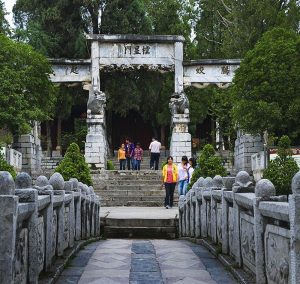
Guangnan County广南县 has a long history and is one of the famous historical and cultural cities in Yunnan province. Guangnan Confucius Temple is one of the best-preserved ancient architectural complexes in Guangnan County, located in Guangnan No.1 Middle School, Wenhua Road文化路, Guangnan County. The temple was built in 1709 and has a history of more than 300 years. After the Yongzheng雍正, Qianlong乾隆 and Daoguang道光 emperors’ expansion, the temple reached an area of more than 9,000 square meters, a total of five courtyards, and is the largest temple in Guangnan County. Dacheng hall大成殿 as the main body, there are sacrificial utensil room祭器室, the temple of local respectable dead persons乡贤祠, ward room官厅, Lingxing gate stone memorial archway棂星门石坊, Panchi pool泮池 and so on. Hallow Temple崇圣祠 is behind Dacheng hall, and on the right of Dacheng hall, there are Minglun hall明伦堂, Lianfeng academy莲峰书院, Jiexiao ancestral hall节孝祠 and other palaces. Dacheng Hall, Dacheng gate大成门 and Panchi pool are well-preserved now, Lingxing gate stone memorial archway still stand there. Other ancient architectures have been pulled down or reconstructed.
Nearby Attractions
1. Babao Scenic Area八宝风景区
Babao provincial level scenic area is located in the southeast of Guangnan County, Wenshan Autonomous Prefecture, 160 kilometers away from Wenshan. The Babao scenic area is dominated by peaks cluster, peak forests and karst waterfalls. It is composed of four sections, including Babao, river, Tangna cave汤纳溶洞 and Sanla waterfall三腊瀑布, with a total area of 68 square kilometers.
2. Bamei Scenic Area坝美景区
Bamei village of Bamei Town, Guangnan County is surrounded by mountains. Because of its unique karst landforms, caves, rivers and villages, people in and out of the village must sail through the cave. The land in front of the village is flat and open and behind the house there are green bamboos, which are similar to the Jin Dynasty litterateur Tao Yuanming陶渊明 described the Peach Blossom Spring桃花源, so it is called “The Last Xanadu”. People at Bamei are dominated by Zhuang people. Taoyuan Cave桃源洞 and Tangna Karst Cave汤纳溶洞 are the entrance and exit of Bamei Village.
How to Get There
Guangnan Confucius Temple is located in the county seat of Guangnan County. Transportation there is relatively convenient.
1. By Long-distance Bus
Long-distance route is Kunming-Wenshan-Guangnan, you need to transfer in Wenshan.
Kunming East Bus Station-Wenshan Bus Terminal
Departure Time: 7:20-20:10
Price: 126 or 117 or 140 CNY
Distance: 317 kilometers
Consume Time: 4-4.5 hours
Wenshan Bus Terminal-Guangnan Bus Terminal
Departure Time: 6:20-17:40
Price: 47 CNY
Distance: 178 kilometers
Consume Time: 2.5-3 hours
Tips: The price and time are for reference only, specific with actual condition. More prices and departure time, you can ask for details at bus terminals.
2. By Railway
Now, train is more convenient and faster than long-distance bus from Kunming to Guangnan County.
Kunming Station-Guangnan County Station
Departure Time: 10:36, 12:00, 12:19, 13:35, 13:52, 17:12
Price: 119.5 CNY
Distance: 424 kilometers
Consume Time: About 2.5 hours
Kunming South Station-Guangnan County Station
Departure Time: 7:30-17:40
Price: 109 CNY
Distance: 417 kilometers
Consume Time: About 2 hours
Best Time to Visit
Guangnan Confucius Temple visit is mainly indoor activities, so you can visit there all the year round.
Accommodation in Guangnan County
You can stay overnight in the county seat of Guangnan County.
1. Guangnan Babaogong Hotel广南八宝贡酒店
Address: Close to Guangnan Bus Terminal, Guangnan County, Wenshan文山自治州广南县广南汽车客运站附近
Tel: 0876-5155999
Starting Price: 352 CNY
2. Guangnan TeAnNa Hotel广南特安呐酒店
Address: No.255, Beining Road, Guangnan County, Wenshan文山壮族苗族自治州广南县北宁路255号
Tel: 0876-5151299
Starting Price: 260 CNY
3. Xanadu(Shiwai Taoyuan) Hotel世外桃源大酒店
Address: No.18, Babao Road, Nanxiu Community, Liancheng Town, Guangnan County, Wenshan文山州广南县莲城镇南秀社区八宝路18号
Tel: 0876-5619999
Starting Price: 350 CNY
Useful Travel Tips
1. Learn something about Confucian culture in advance.
2. In summer, the weather in Guangnan county is rainy, remember to bring rain gear. In winter, the temperature difference is large between daytime and night, please bring coats to keep warm and prevent a cold.
Tours including Bamei Village in Guangnan County
2 Days Bamei Xanadu Village Tour from Kunming by Speed Train
3 Days Puzhehei Lotus Flowers Tour and Bamei Xanadu Discovery By Speed Train(June,July,August)
6 Days Yunnan Ancient Villages Tour with Puzhehei Scenic Area and Bamei Xanadu Village
8 Days Yunnan-Guizhou Karst Landform Tour and Ethnic Minorities Discovery
About Nagu Hui Ethnic Town
Nagu Hui Ethnic Town is located in the northwest of Tonghai County, backed by the Shizi(Lion) Mountain, facing Qilu Lake(杞麓湖), 14 kilometers from the county seat and 110 kilometers from Kunming, with an average elevation of 1800 meters. Nagu Ethnic Town is composed of Najiaying Village(那家营村), Gucheng Village(古城村) and Sanjia Village(三家村), is the hometown of overseas Chinese and handicraft, covering an area of 12 square kilometers. All the residents of the ethnic town are Hui people who believe in Islam, they maintain their own cultural traditions and customs. No matter diet and daily life, weddings and funerals, all have rich local characteristics and ethnic characteristics. There are three mosques in the ethnic town, one of which is Najiaying Mosque.
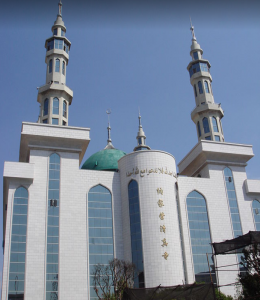
Why is Najiaying Mosque So Special?
Najiaying Mosque(纳家营清真寺) is located in Nagu(纳古) Hui Autonomous Ethnic Town, Tonghai County, Yunnan Province. It is an ancient Islamic Mosque in China. The mosque was built in the early Ming Dynasty Hongwu period(洪武年间) (In 1370), the current building was rebuilt in 2001, officially completed on October 2, 2004. Built according to the mountain, it is divided into five levels. The building area of the temple is about 10,000 square meters. It is the center of religious activities and education for Nagu Muslims.
Architectural Features
- Main Prayer Hall: The mosque’s main prayer hall is notable for its traditional Chinese architectural style, incorporating both Islamic and local design elements. The hall can accommodate a large number of worshippers, providing a serene environment for prayer and reflection.
- Minaret: The mosque features a beautifully designed minaret, which serves as a focal point for the call to prayer. The structure showcases intricate craftsmanship and architectural finesse.
- Courtyard: The mosque’s courtyard is spacious and well-maintained, offering a peaceful setting for community gatherings and religious activities.
Cultural Significance
Najiaying Mosque is not only a religious center but also a hub for cultural and educational activities. It plays a vital role in the preservation and promotion of Hui Muslim culture and traditions in Yunnan.
Educational Programs
The mosque often hosts educational programs, including classes on Islamic studies, Arabic language, and religious practices. These programs aim to enrich the knowledge and spiritual life of the community.
Community Events
Various community events and festivals are held at the mosque, fostering a sense of unity and belonging among the local Muslim population. These events provide an opportunity for cultural exchange and communal bonding.
Muslim Travel Tips
For Muslim travelers visiting Najiaying Mosque, here are some helpful tips:
- Prayer Facilities: The mosque provides ample space for daily prayers. It is recommended to check the prayer timings and join the congregation for a fulfilling spiritual experience.
- Cultural Engagement: Engage with the local community to learn about their customs, traditions, and way of life. The mosque is a great place to gain insights into the Hui Muslim culture.
- Dress Code: Dress modestly and appropriately when visiting the mosque. Women are advised to wear headscarves, and both men and women should ensure their attire is respectful of the religious setting.
- Etiquette: Follow the mosque’s rules and guidelines to show respect for the local customs and religious practices. Avoid making loud noises and maintain a peaceful demeanor within the mosque premises.
- Local Cuisine: Don’t miss the opportunity to try local Halal cuisine. The area around the mosque often has vendors and restaurants offering traditional Hui dishes.
Nearby Attractions
Sansheng Palace in Tonghai County, Yuxi
Hexi Confucius Temple in Tonghai County
Xiushan Mountain Park in Tonghai County
The Last Mongols in Yunnan
Xiahuicun Mosque
Best Time to Visit
You can visit Najiaying Mosque at all seasons.
How to Get There
Najiaying Mosque is about 14 kilometers from the county seat of Tonghai County. After arriving in Tonghai County, you can take a taxi to Najiaying Village, Najiaying Mosque is in the village. Najiaying Mosque is easily accessible from Tonghai County and Yuxi City. Public transportation, taxis, and private vehicles can be used to reach the mosque. It is advisable to check local transport options and plan your visit accordingly.
Najiaying Mosque stands as a testament to the rich Islamic heritage in Yunnan Province, offering a blend of spiritual, cultural, and historical experiences for visitors.
1. By Long-distance Bus
There are long-distance buses from Kunming to Tonghai County.
Kunming East Bus Station-Tonghai Bus Terminal
Departure Time: 6:58-18:00
Ticket Price: 42 CNY
Distance: 138 Kilometers
Consume Time: About 2.5 hours
2. By Train
Kunming Railway Station-Tonghai Railway Station
Departure Time: 7:45, 11:02, 12:30, 15:41
Ticket Price: 21.5 CNY
Distance: 139 Kilometers
Consume Time: About 2 hours
Accommodation Around Najiaying Mosque
Najiaying Mosque is not far from the county seat of Tonghai County. You can stay in Tonghai County for Overnight.
Useful Travel Tips
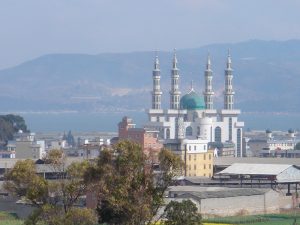
1. If you are not a Muslim, learn something about Muslims, mosques and local Hui People in advance;
2. Respect Muslim Culture and do not make noise in the mosque.
3. Know some general situation of Najiaying Village in advance.
4. You can participate in some cultural activities during festivals.
Tours Including Xingmeng Mongolian Village in Tonghai County
Xingmeng Mongol Ethnic Town(兴蒙蒙古族乡) is not far from the county seat of Tonghai County and Nagu Town. Xingmeng Mongolian village(兴蒙蒙古族村) is called the last Mongols in Yunnan. It is worthy to visit the village when you are traveling in Tonghai County of Yuxi.
2 Days Jianshui Ancient Architecture Tour from Kunming
2 Days Yuanyang Hani Rice Terraces Tour at a glance
6 Days Yunnan Small Group Tour with Honghe Hani Rice Terraces
About Chengzhai Village and Bailuo Ethnic People
Located in the Donggan Town of Malipo County in Wenshan, 134 kilometers from the county seat of Malipo County, Chengzhai Village城寨村 is an ancient village hidden in the mountains. Chengzhai Village is an ancient village of Bailuo People, compared with Yi Minority in other areas, Bailuo People at Chengzhai Village exist a big difference. Bailuo people remain their primitive costumes, strange folk custom and unique stilt style architecture. Chengzhai Village was listed as the intangible cultural heritage list of Yunnan Province, and was appointed as the most traditional village in China. The bronze-drum dance was also listed into national intangible cultural heritage protection.
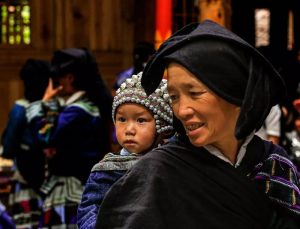
Chengzhai城寨 is a comprehensive expression of Bailuo culture白倮文化. The culture remains in the village is authentic and complete, and the connotation of traditional culture is very rich. That is to say, language, oral literature, music, dance, art, architecture art, sacrifice, etiquette, traditional festivals, customs and habits, etc. are organically combined with the natural environment.
Bailuo白倮, a branch of the Yi ethnic group, have lived at Chengzhai village for several hundred years. Comparing to other Yi ethnic branches, the Bailuo people differ a lot as far as their clothing, dietary habits and dwellings. Due to their quaint costumes, exotic culture and distinctive Ganlan(stilt style houses) architectures, Bailuo people have aroused great attention.
However, the living habits inside the Bailuo tribe vary, and its profound history and profound ethnic culture have further veiled the Bailuo society. Most Bailuo people here seldom conduct intermarriages with other nationalities, and barely have communications with the outside world.
The History of Bailuo Ethnic People
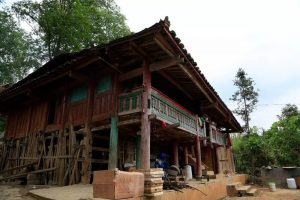
The Stories of Yunnan(Dian Zhi滇志), which was compiled in the Ming Dynasty (1368-1644), once had some records about the Bailuo people白倮人. However, it still remains unknown exactly when the Bailuo people’s ancestors began to move to the southeast of Yunnan.
In 2009, Chengzhai Village城寨村 was listed into the second batch of the intangible cultural heritage list of Yunnan Province.
The Features of Bailuo Ethnic Group
1. The Ganlan Architecture(stilt style architecture)
It is the traditional architectural style of the Bailuo people, using 52 (56 or 66) columns in eight rows to support the whole building. Such a house normally has two storeys, coupled with a stable. The first floor is for people to live at, and the second is used for storage; and the roof is paved with tiles.
As the typical representative of the Bailuo ethnic culture, Chengzhai Village exhibits the historical and cultural remaining on a real and integral basis. The rich cultural connotations here have included the Bailuo ethnic language, (oral) literature, music, dance, fine arts, architecture, sacrificial ceremonies, etiquette, traditional festivals, and many other ethnic customs.
2. Buckwheat Festival荞菜节
The buckwheat festival is the grandest festival of the Bailuo people of Chengzhai Village.
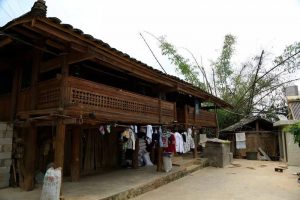
A local legend goes that, in the ancient times, a big fire broke out in the Bailuo ethnic village, torching down all the houses and grains. The villagers were in deep sorrow. All of a sudden, a villager found some grains of buckwheat under a reversed bowl, and grew them in the fields. Several months later, the buckwheat plants brought a harvest, saving the starving village.
In order to express thanks to the buckwheat, the Bailuo ethnic villagers determined to spend the three-day Buckwheat Festival on the first Dragon Day of he lunar calendar. People always carry out religious ceremonies during the festival to pray for abundant rainfall.
3. The Batik Craft
Enriched by the ethnic culture, the batik craft highlights the culture of the Bailuo people who are traditionally adept at making quaint, elegant costumes on their own. Carrying modern aesthetic elements, and with delicate workmanship, it has brought great visual impacts one can’t help marveling at. Bailuo people have inherited the ancient weaving skills from their ancestors.
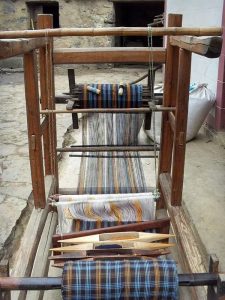
4. The Bronze-drum Dance铜鼓舞
Bronze-drum dance is one of the traditional dances of the Bailuo people白倮人. As a kind of dance performed when Bailuo people hold sacrificial ceremonies for their ancestors, it reflects the Bailuo people’s worship for nature and ancestors. Usually, only one person beats the drum, and dancers perform to the beats in a counterclockwise way, singing some solemn tones. The drum dance, which includes more than 30 routines, is a massive entertaining activity of the Bailuo people. It is performed on the fairground of the village and can be joined by at least 100 villagers.
In 2007, the bronze-drum dance of Bailuo people was listed as one of China’s intangible cultural heritages. Lu Xiaozhong陆孝忠 was nominated as one of the drum dance inheritors.
5. Recall The Soul
In the old times, the Bailuo people seldom washed clothes because they believed that people’s souls are attached to the clothes they worn. Therefore, every time they washed clothes, they had to slaughter a rooster for recalling the soul. Today, assimilated by other cultures, the Bailuos have barely kept the tradition.
How to Get there
1. By Long-distance Bus
The route is Kunming-Malipo County-Donggan Town-Chengzhai. There are long-distance buses from Malipo County to Donggan Town. Then another 1 hour is needed from Donggan Town to Chengzhai.
Kunming East Bus Station-Malipo Bus Terminal
Departure Time: 11:00, 18:30
Price: 137 CNY
Distance: 394 kilometers
Consume Time: 6 hours
2. By Train
If you want to take train, you should go to Zhulin Station珠琳站 in Guangnan county first. Then another 2 hours is needed from Zhulin Railway Station to Malipo County.
Kunming Railway Station-Zhulin Railway Station
Departure Time: 17:12
Price: 103 CNY
Distance: 413 kilometers
Consume Time: 2 hours
Kunming South Railway Station-Zhulin Railway Station
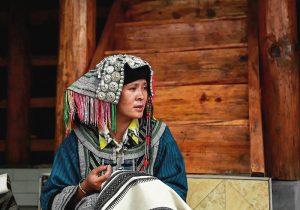
Departure Time: 7:30
Price: 92 CNY
Distance: 407 kilometers
Consume Time: 1.5 hours
Best Time to Visit
No matter when you go to Chengzhai Village, you can feel the profound history and strong ethnic culture there. Therefore, Chengzhai Village visit is available all the year round.
Accommodation Around Chengzhai Village
You are suggested to return to Malipo County for overnight, accommodation conditions in Malipo County is better.
1. Jingda Hotel麻栗坡靖达酒店
Address: Laixi Development Zone, Malipo County, Weshan文山州麻栗坡县莱溪开发区
Tel: 0876-6622888
Starting Price:130 CNY
2. Guohao Hotel麻栗坡国豪大酒店
Address: No.190, Yuerbei Road, Malipo County, Wenshan文山州麻栗坡县玉尔贝路190号
Tel: 0876-6629888
Starting Price: 149 CNY
3. Yajing Theme Hotel麻栗坡雅景主题酒店
Address: No.260, Yuerbei Road, Mali Town, Malipo County, Wenshan文山州麻栗坡县麻栗镇玉尔贝路260号
Tel: 0876-6621777
Starting Price: 94 CNY
Useful Travel Tips
1. Learn something about Bailuo culture and Buckwheat Festival荞菜节 in advance.
2. Chengzhai Village is relatively remote, you will spend a long time on the long-distance bus.
China’s Sanchahe Nature Reserve in Mengla County, Yunnan Province, is located in a tropical rain forest corridor that stretches from China into neighboring Burma and Laos. Sanchahe Nature Reserve is famous for its biodiversity and undisturbed habitats for both animals and plants. To better facilitate the scientific study of these habitats and to provide sustainable access to tourists without unduly interrupting the activity of the animals (interrupting the wild elephants can in fact be life-threatening, so one is advised never to attempt to approach these shy animals) or trampling the flora under foot, a 2½-kilometer-long aerial walkway was constructed with the help of a $300,000 grant from a U.S. wildlife organization.
Chinese Name:西双版纳望天树空中走廊
English Name: Air Corridor of Wangtianshu Scenic Area in Mengla County, XishuangBanna
The aerial walkway was an integral part of the eco-tourism plans of Sanchahe Nature Reserve, as it was felt that providing visitors an open-air museum, as it were, helps to raise awareness of the plight of the tropical rain forest (there are a number of rare tropical plants here which scientists believe may hold the key to the cure of known as well as yet-to-be-known diseases) on the one hand, and, on the other hand, provides income to the local population, thus obviating the need to exploit the rain forest for the purpose of a livelihood, which exploitation could very well result in the irrevocable loss to mankind of potentially beneficial, medicinal plants.
The walkway, or footbridge, is suspended between a series of very straight and very tall (up to 80 meters high) indigenous trees, the Parashorea chinensis* (aka “the giant of the rain forest”), by means of steel cables onto which are attached the ropes which support the walkway itself. Below one may be lucky enough to spot any of a number of endangered animal species such as the golden monkey or the wild peacock or – if one is very, very lucky – a flock of wild elephants, though these tend to be quite shy, as indicated.
For those who wish to overnight in Sanchahe Nature Reserve a tourist villa in the shape of a bird’s nest can be rented for the night. There is also an elephant show at Sanchahe that will delight anyone who enjoys watching these amazingly quick-learning, intelligent animals perform.
There is a tree called the Wang Hsie Tian, or simply Wang Hsie, after the botanist who identified it in 1992 (aka the “species authority”), but the tree is better known in Sanchahe Nature Reserve by its pictoresque monikers, the “looking-up-to-the-sky tree” and the “cloud-kissing tree” (a tree’s equivalent of “sky scraper”?). Prince Philip, President Emeritus of the World Wildlife Fund, paid a visit to Xishuangbanna in 1986, where he planted a specimen of the Wang Hsie Tian. The tree’s botanical name is, as indicated, Parashorea chinensis (or simply Shorea chinesis), but it is sometimes referred to as Shorea wangtianshuea, in deference to its identifying authority.
How to get there:
Take the regional bus from the city of Jung Hong to Meng La county. From there one must take a special mini-bus out to the Sanchahe Nature Reserve Aerial Walkway via a 20-kilometer gravel road. Price: 3.00 yuan to 5.00 yuan, depending on where one boards the regional bus.
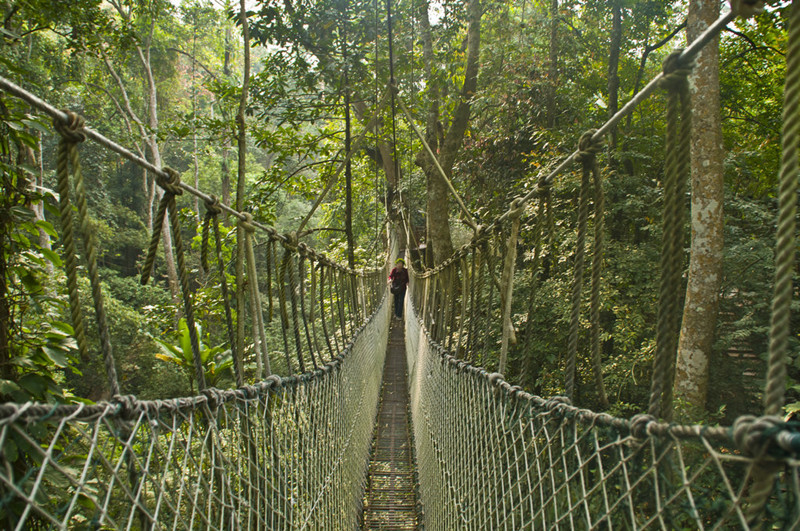
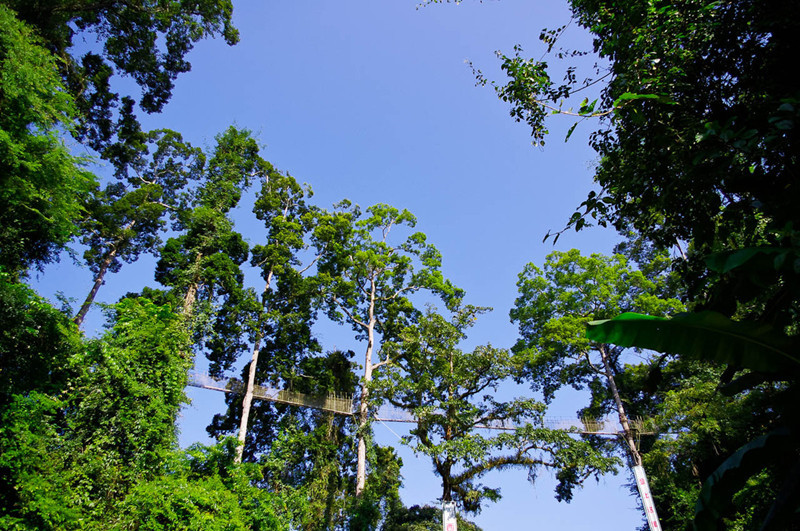
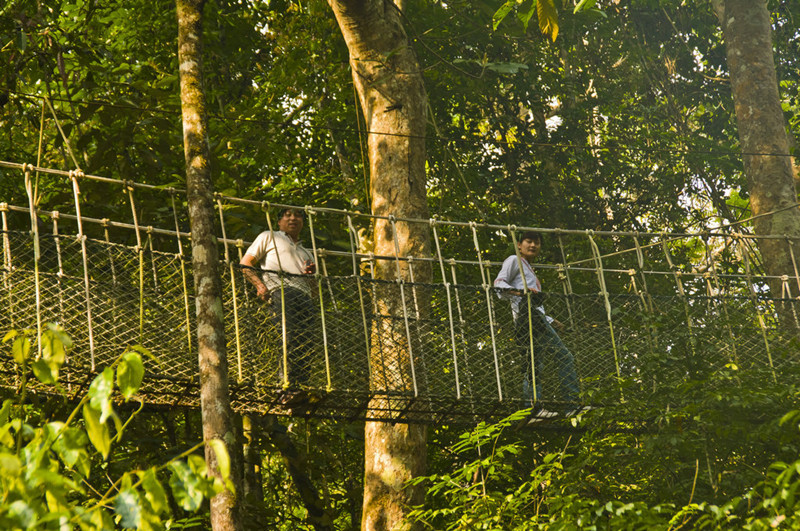
Why is Dayingjiang River So Special
Beautiful Dayingjiang River runs through Yingjiang County in west Yunnan border area. The river mouth is open and its surface is as flat as a mirror. In the sunny days, the limpid river lies as smooth as silk. Along the both sides of the river, distant mountains loom and forest is dyed black. Umbrella-like banyan forest looks lush and green. In the converging place of clouds and water, a bamboo raft is moving away. In the distance, since the river is set off by bamboo forest, a unique scene appears that the river overflows the bamboo grove and bamboo grove places the river in between. The hundred-meter-wide river is tightly locked by two pieces of rock cliff at Tiger Leaping Stone.
The distance between the two cliffs is only seven meters. The pouring torrent clashes the high mountains which rise abruptly along the gorge. The increasingly large fall of river generates glittering foam and the thundering uproar in the gorge can be heard several kilometers away. Considering the pouring torrent, deep riverway and giant stone emerging in the middle of the river, small waterfalls can be seen everywhere. The mountains stand facing each other on both sides of the river, posing a natural wonder of “a seam of sky if people look up and a thread of river when having a bird view.”
Where is Dayingjiang River-Location
Dayingjiang River is a branch at the upstream of Irrawaddy River. It takes its rise from Danzha River and Binglangjiang River in Tengchong City. The two rivers join up with each other in the Old town of Yingjiang County, and then form the Dayingjiang River, which flows through Tiger Leaping Stone and then runs south to the Irrawaddy River in Burma. It finally flows into Bay of Bengal. Dayingjiang River is about 205 km long with 146 km in Yingjiang County.
How to Get to Dayingjiang River
After arriving in Yingjiang County, it is convenient to get to Dayingjiang River by taxi, which takes about 40 minutes. For those people who are bike lovers, it is good way to get to Dayingjiang River by bike, which takes about 2 hours.
Introduction of Dayingjiang River

Dayingjiang River is a branch at the upstream of Irrawaddy River. It takes its rise from Danzha River and Binglangjiang River in Tengchong City. The two rivers join up with each other in the Old town of Yingjiang County, and then form the Dayingjiang River, which flows through Tiger Leaping Stone and then runs south to the Irrawaddy River in Burma. It finally flows into Bay of Bengal. Dayingjiang River is about 205 km long with 146 km in Yingjiang County. The river is 900 meters wide at its widest point and only 7.5 meters narrow at its narrowest point (Tiger Leaping Stone). There are two large branches, Binglangjiang River and Nandi River, at its upstream.
High trees and strange stones can be found along the two banks of Binglangjiang River. The water in the river runs very fast and high. After entering the dam area and joining with Nandi River, the river becomes quiet and winds to the west. The huge banyan trees are easily found along Dayingjiang River area, and Dai villages can be seen among the bamboo forests, which represent typical tropical and subtropical scenery. After winding through hundreds of primeval forests and canyons to arrive at Yingjiang Bamboo forest, the river turns slow and wide. On the two banks are endless farmlands and villages. A bamboo dam spreading thousands of miles stand on the riverbanks, and green islands can be seen in the middle of the river. Blue sky, white clouds, green bamboo and islands that are reflected in the river water, as well as small boats and Dai ethnic love songs constitute a fancy poem. In this scenic spot, there is not only original natural ecology, but also national customs. The integration of natural landscape and ethnic culture has become a feature of the area. This scenic area is based on the Yingjiang Section of Dayingjiang River, starting from Zhina Township in the north and Mangyun Township in the south. It also depends on the natural ecology of Dayingjiang, as well as numerous scenic spots. It mainly includes seven scenic areas: namely Zhina “Guangbang” drum cultural area, Dao Anren hometown, the original place of Dai opera, Old Town Xiang’e Lake area, customs area, Wanxiang old town area and monument of Margary affair. Water-Splashing Festival, Munaozongge Festival, national sports competitions, beach sports activities and other projects have also attracted many tourists.
Best Time to Visit
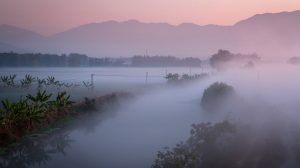
It is suitable to visit Dayingjiang River all year around. Every season has its unique beauty.
Nearby Attractions
XiangEhu Lake
Located in the southwest of Jiucheng Town of Yingjiang County, the beautiful XiangEhu Lake is the gateway and business card of Jiucheng Town. There are natural wetlands, sparkling natural lakes, and thousands of acres of lotus ponds with unique charm. XiangEhu Lake has a large amount of water, is not dry all year round, has good water quality, and contains many trace elements needed by the human body. There are more than ten kinds of wild fish in the lake, as well as birds such as egrets, yellow ducks and wild ducks, as well as aquatic plants such as lotus, reed and water hyacinth.
Yunyan Stupa
Yunyan Stupa in Yingjiang County, also known as Manmengding Stupa, is located on the top of Yunyan Mountain, 1 km east of Yingjiang County. “Yunyan” in Dai Language means an auspicious, joyful and fascinating place. It is one of the most important Buddhist pagodas of Hinayana in Yunnan. The pagoda was built in 1947 and it took eight years to complete the work. Although it is a modern product, it is rich in ancient style and is listed as a key cultural relic protection unit in Yunnan Province.
Yingjiang Hornbill Valley
Yingjiang Hornbill Valley is located on the bank of the Hongbenghe River in Yingjiang County, Dehong Dai and Jingpo Autonomous Prefecture, Yunnan Province. It belongs to the Hengduan Mountains extending from the Himalayas. The highest point is that the Daniangshan Mountain in Zhina Township is 3404.6 meters above sea level. The lowest point is that the Estuary of Nabanglashahe River is only 210 meters above sea level. The huge difference in altitude forms a cluster of northern tropical, subtropical and temperate climates, namely, the typical three-dimensional climate of the river. The forest coverage rate in Yingjiang County is 73.9%. There are many kinds of birds living here. At present, there are 550 species of birds found and recorded in Yingjiang, accounting for more than one-third of the national birds. The unique and precious Buceros bicornis, anthracoceros coronatus and Rhyticeros undulatus settle here. Therefore, it has the reputation of “Chinese Hornbill Valley”. Yingjiang is a beautiful and magical place, a paradise for birds, a kingdom of flora and fauna.
Chinese Name:云南弥勒红酒庄
English Name: Yunnan Red Wine Villa in Mile County, Honghe
Yunnan Red Wine Villa, which is a national agricultural demonstration site, is located beside the Kunming-Hekou Highway, 14 kilometers from the seat of the Mile County. It is a grape garden integrating tourism, dining, entertainment, accommodation, reception, business and holiday spending. Unique red wine villa combining both Chinese and western cultures will certainly make you drunk in the sceneries. The beautiful natural garden will make you relax your every nerve and the high-quality red wine will make you personally experience what the life could be. It is a romantic place with red sunset, church and a grape farm of 20,000 mu.
The villa has a high-quality wine grape planting base of 20,000 mu. The grape varieties include the Rose Honey, Cabernet Sauvignon and Wild France. The villa also has international-level large-scale wine workshops and first-class wine making equipment.
You could personally see every wine-making procedure in the villa and taste the beauty of all types of red wines. Just enjoy yourself and you will never regret! Not only the villa has special wines you could not buy in the market, but also the prices of the wines are inexpensive. The villa could even design wines according to your own person taste, making you and your wine both unique.
Chinese Name:建水古井
Engish Name: The Ancient Wells in Jianshui County, Honghe
Dozens of ancient wells scatter in the ancient town of Jianshui, Honghe Prefecture. Some of them are single-mouthed, double-mouthed, triple-mouthed, quadruple-mouthed, and even twelve-mouthed. So ancient wells can be a wonder deserving to be explored in Jianshui!
First dug in the early Ming Dynasty (1368-1644), Hongjing Well is situated in Hongjing Street. It is a double-mouthed well and is also one of the famous Eight Sights of Jianshui in ancient times.
Longjing Well in the northeast of Jianshui Ancient Town has enjoyed a history of about 600 years. Its water tastes much like that of Longjing Well of Longjing Temple in Hangzhou of Zhejiang Province; and it was made by war refugees from Zhejiang, so it is named reasonably as “Longjing Well”!
Otherwise called Liquan Spring, Dongjing Well is the eldest well of Jianshui, having a history of more than 700 years (first dug in the Yuan Dynasty). Its sweet and crystal-clear water is said to be the best to make tea with in Jianshui-made purple-sand pots.
Dubbed as the “first well in south Yunnan”, Daban Well is the most famous of its kind in Jianshui. Apart from making tea with, its water is considered by locals the most ideal to produce beancurd (Tofu) and rice noodle.
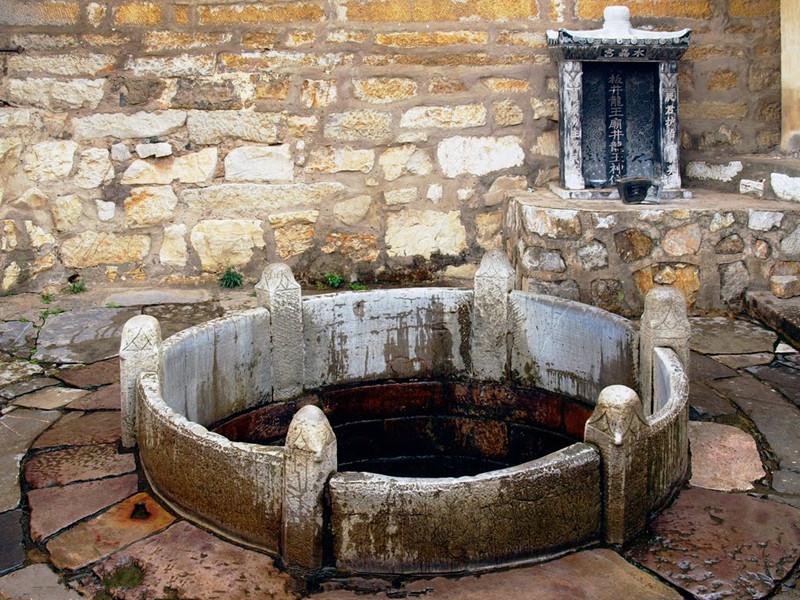
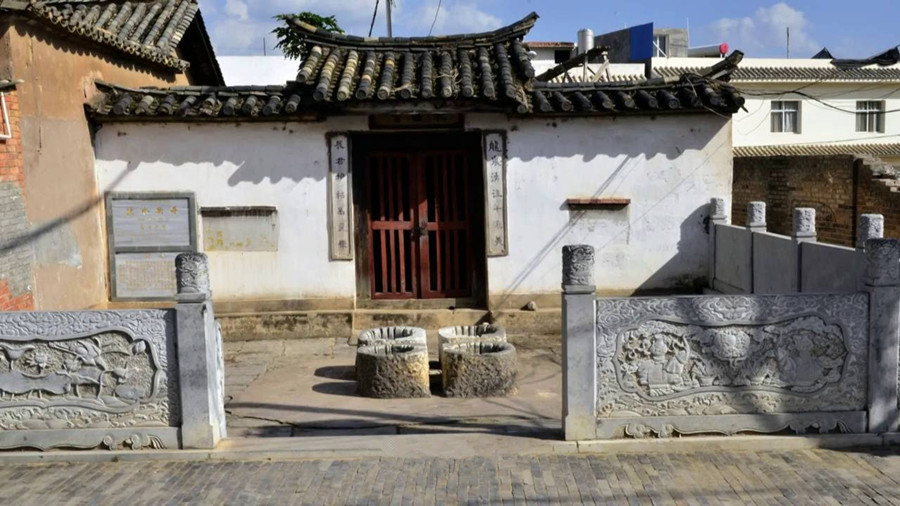
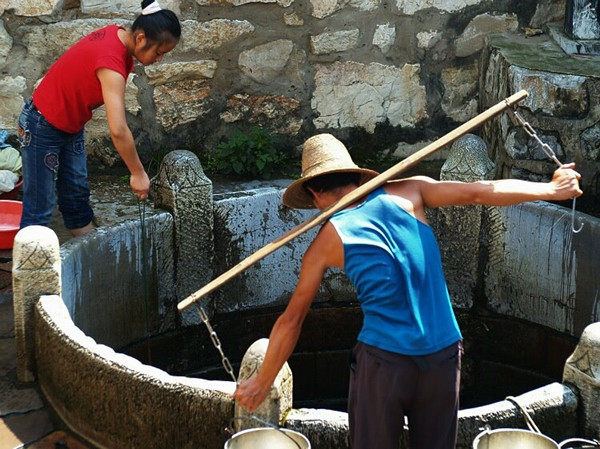
Location:
Why is Moli Waterfall So Special
Moli Waterfall, also known as Zhaduo Waterfall, is located in the Moli Canyon in the junction of Mangshi, Luanchuan and Ruili. It is hidden in the deep tropical rain forest between Guangnong Mountain and Guangma Mountain. The clear spring water pours down from the steep cliff of 60 meters high, forming a scene of “stacked water like cotton, without the use of bows and flowers to scatter.” It looks like a huge white silk fluttering in the air, and dancing clouds between the peak cliffs. The sound is like thunder, and there are hot springs under the waterfall. The landscape is very unique. Moli Waterfall is the largest waterfall in Dehong and even southwest of Yunnan.
Where is Moli Waterfall-Location
It is located in the Moli Canyon in the junction of Mangshi, Luanchuan and Ruili.
How to Get to Moli Waterfall
It is inconvenient to take a bus to get to Moli Waterfall. Because it is approximately 5-6 kilometers away after getting off the bus. Therefore, it is a best choice to charter a car to Moli with the price of 50 RMB for single way.
Best Time to Go
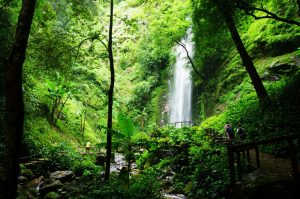
Spring and fall are the best time to visit Moli Waterfall, because the air is moist, which makes people very comfortable.
Nearby Attractions
Moli Tropical Rainforest
Moli Tropical Rainforest, is known as its tropical rainforest view and Buddhist holy land, the whole scenic area is 1.5 kilometers long. Moli, also known as Zhaduo, refers to a grand waterfall. Moli is known as a natural oxygen bar, which is healthy for people.
One-Tree Forest
In fact, One-Tree Forest is a large banyan tree, which has a history of more than 900 years, with 32 earial roots streight pinning into the earth. Banyan is a special and unique landscape in Ruili, it’s everywhere no matter in the vallies or villages or on the sides of the roads. people value banyan as holy tree, so they only plant these trees but don’t cut them. The big Banyan is in the one-tree forest park, and it’s 28 meters, what makes it more precious is that it has been standing there for over 200 years. The tree has many aerial roots hanging down from above, and they are interwined with one another, ending in the root. there are also so many aerial roots hanging down and they took roots in the earth, forming a forest that makes up of pillar-like roots, thus one-tree forest is shaped. It’s a very attractive and magical natural scenery. One-tree Forest has become a scenery that tourist must go, and it’s one of the hottest sceneries in Ruili.
Tours Including Moli Waterfall
39 Days Yunnan 25 Ethnic Minorities Discovery and Photography Tour
22 days Yunnan Birds Watching Tour
Why is Nandian Xuanfu Chieftain Office So Special
Built in the first year of the emperor Xianfeng of Qing Dynasty in 1851, Nandian Xuanfu Chieftain Office is located at No. 103 Nandian Road, Zhewu Town, Lianghe County, Dehong. It is the best preserved chieftain government in Yunnan Province, announced on November 27, 1996 as the national key cultural relic’s protection unit. It is also the only currently unique national cultural relic’s protection units in Dehong Prefecture.
Nandian Xuanfu Chieftain Office, was decorated in accordance with the Han government office style, by 5 halls, 10 side rooms, 4 courtyards, 47 buildings, and all together 149 houses, covering an area of 10,625 square meters. The chieftain office can be divided into the tribunal, the parlor, the chamber, the center hall, the back garden, and 5 halls together with 10 side rooms by the hierarchy.
Where is Nandian Xuanfu Chieftain Office
Nandian Xuanfu Chieftain Office is located at No. 103 Nandian Road, Zhewu Town, Lianghe County, Dehong Jingpo and Dai Autonomous Prefecture.
History of Nandian Xuanfu Chieftain Office
Xuanfu Chieftain was the regime dispatched by the central government in the feudal era to govern the frontier area, which ranked second among the three kinds of chieftains: Xuanwei Chieftain, Xuanfu Chieftain, and Anfu Chieftain in the local government. Xuanfu Chieftain who is the equivalent of a local emperor had the ultimate power of life and death. Entering the tribunal, visitors can view a kylin screen which is the symbol of the fourth-grade officials. The chieftain office is known as a government office in feudal China. In addition to the office, there are accommodations and some required ancillary buildings.
The chieftain official named Gong, originally from Nanjing, was born in Shangyuan County, Yingtianfu. In the fifth year of Dade of the Yuan Dynasty(1301), the emperor gave him the surname Dao, so he was also called Daogong. Later on, he was renamed Gong in the first year of the Republic of China. Dao’s ancestors once conquered to Yunnan in Ming Dynasty, and they were appointed as Xuanfu Chieftain Official because of their repeatedly meritorious military service. Then, they settled in Nandian, from 1398 to May 1950, five hundred and fifty-two years, with the succession to the officer of 28 generations.
How to Get to Nandian Xuanfu Chieftain Office
In Lianghe County, it is convenient to get to Nandian Xuanfu Chieftain Office. After arriving at Lianghe County, visitors can take one of the three transportation methods, such as
- By Bus: There are many buses to other counties and attractions in Lianghe County.
- By Taxi: Taxi is a good way to get to Nandian Xuanfu Chieftain Office at the starting fare of 5 Yuan.
- By Bike: For those bike lovers, bike is a good travel method for short distance.
Best Time to Go
It is suitable to visit Nandian Xuanfu Chieftain Office all year round.
Nearby Attractions
Nandian Dragon Pool
The Dragon Pool is like an open fan. There are more than 700 meters around the lake. Around the lake, it is a prefabricated fence carved with birds and beasts, dragons and the Ninth Heaven patterns. There are seven pavilions standing beside the pool. The pavilion is enriched with the artistic style of the southern misty rain and the waterside pavilion. It is simple and elegant, with a patchwork structure, exquisite structure, unique arches, unique craftsmanship, leisure in the pavilion, dancing and playing chess, playing the violin, dating, and viewing and enjoying the fish in the lake. It is a place where leisure and entertainment are integrated. It is also a hotbed for viewing the scenery of the Dragon Pool.
An Overview about China Puer Tea Exhibition Garden
Puer tea is the signature tea of Yunnan Province. If you love tasting this tea with fullness of flavor, it is suggested to visit the China Puer Tea Exhibition Garden in Yunnan Province.
Located at the Yingpan Mountain(营盘山), 29km from Simao District(思茅区), Puer City(普洱市),Yunnan Province, and near Puer National Park, the China Puer Tea Exhibition Garden is an ideal place for growing Puer Tea because of the pleasant climate and great environment.
China Puer Tea Exhibition Garden was built with the ecological tea garden as the construction background, surrounded by all the green hills. It is a bright pearl in the tea sea with its unique and breathtaking scenery.
The entire scenic area gives visitors a three-dimension representation of the amazing tea content and culture from Puer tea origin, evolution, development, plant production, national origin, processing and packaging, history and culture, the collection and marketing, cooking and tasting, all these different angles.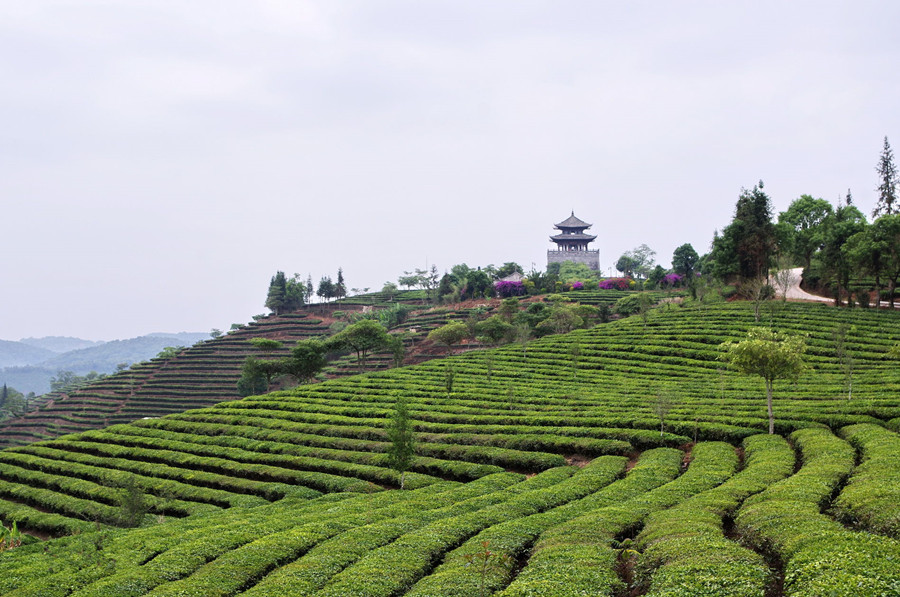
The Introduction of the Exhibition
The core area of this exhibition garden covers an area of 191000 square meters, 1700 meters above sea level. The core travel area is composed by nine sections such as China Puer Tea Museum(普洱茶博物馆), Ethnic Villages (村村寨寨), Dream of The Road(梦之路), , Puer Tea Processing Workshop(普洱茶制作坊), Tea Ancestor Hall(茶祖殿), Puer Tea Appreciation Garden(品鉴园), Tea Picking Area(采茶区), Tea Enquiry Tower(问茶楼), Harmonious Garden(和谐园), Xianyiju Hotel(闲怡居酒店) . There you can fully experience and enjoy tea-leaves picking, processing, and exquisite drinking art, as well as buying some to appreciate at home.
The exhibition displays Puer tea process, the relevant cultural relics of Puer tea, some calligraphy and painting about Puer tea, which fully embodies the profound Puer tea culture. Puer Tea Expo Garden functions as the perfect place for general visitors to experience the puer tea culture, appreciate the ethnic customs, and enjoy the leisures.
The Attractions in the Exhibition
Upon entering the scenic area, the terraced green ribbon-like route extents and brings you to the picturesque tea garden. Walking along the zigzag road to the top point of the garden – Tea Enquiry Tower, a three layered building with classical decorations, where you can have a good bird’s eye view of the tea paradise. Then you will see the Puer Tea Museum, which houses many pictures and artifacts related to Puer Tea culture.
Besides, there is a village in the garden, composed of typical dwelling houses of five minority groups, such as the Dai, Wa, Yi, Lahu and Hani, where you can appreciate their unique tea culture. Listening to the special ethnic songs and dancing with them will bring you great enjoyment. It would be joyful to have fun at a campfire party at night. Perhaps you will be fortunate to witness the local traditional marriage custom. Next to the village is Jiahuifang(嘉烩坊), which holds many classical-style buildings. You can buy tea products and relevant wares there.
The Puer Tea Processing Workshop(普洱茶加工坊) is located in the tea-covered mountain suffused with faint scent of tea trees. During the end of February and November, visitors can go there to experience the tea leaves picking enchanting with the beautiful folk songs the local tea growers sing. You can also pick tea leaves and participate in its making process. After that, don’t miss the Tea Ancestor Hall(茶祖殿), where there worships sculptures of the tea sage Lu Yu(陆羽)and Ba Yanleng who was the primitive discoverer of tea cultivation.
Come here if you are tired of the fast pace of modern life. Visit the exhibition garden and the wind of the green sea will blow away all your worries. The local hospitable minority groups have already prepared the best Puer tea for you. Have a cup of green tea, and you will be refreshed immediately by its clear fragrance!
Attraction Transportation
Transportation There are regular buses operating between Puer Hongfeng Coach Station and Yingpanshan from 08:30 to 17:00 every half an hour to an hour. Upon getting off, walk to the exhibition garden. Buses for the return journey are scheduled from 07:00 to 14:00.
(Note: Bus schedule is just for reference. It may change from time to time.)
China Puer Tea Exhibition Garden Travel Guide
Title: Spend a Day as a Pu’er Tea Enthusiast
Summary: Transportation Options:
- A. Self-Drive: From Pu’er City, drive towards Jiangcheng for about 7 kilometers (passing by Tianshili Dipu’er Industrial Park), then turn right and continue straight for another 14 kilometers.
- B. By Bus: Purchase tickets at Hongfeng Bus Station (near the Electrical Plant) in Pu’er City to take a bus to Yingpan Mountain. The fare is 12 RMB per person. Bus departure times are between 06:50 and 17:00. Return buses from the Tea Expo Garden to Pu’er City run from 07:00 to 18:00. Departure times may vary depending on the day’s passenger flow, so it is recommended to call Hongfeng Bus Station for the latest schedule.
Admission:
- Entrance Ticket: 50 RMB per person per visit
- Electric Cart Ticket: 20 RMB per person per ride
- Tour Guide Rental: 50 RMB per guide
Scenic Area Experience 1
Title: Three-Hour Tour of the China Tea Expo Garden
Summary: After arriving at the China Tea Expo Garden, start by exploring local villages to experience ethnic culture. Then, visit the Wencha Building, walk through the Dream Road, and arrive at the Xianyi Hotel. Along the way, you can enjoy the scenic beauty of Shengshi Yipin and explore the tea and ethnic culture at the Tea Ancestor Hall.
Keywords: Tea Viewing, Tea Inquiry, Tea Observation
Scenic Area Experience 2
Title: In-Depth Tour of the China Tea Expo Garden
Summary: At the Tea Expo Garden, you can fully understand the process of tea making, tea crafting, tea inquiry, and tea observation.
Keywords: Wencha Building, Museum
Introduction:
- Accommodation: Xianyi Hotel
Scenic Area Experience 3
Title: One-Hour Tour of the China Tea Expo Garden
Summary: At the China Tea Expo Garden, you can gain a comprehensive understanding of the history and development of Pu’er tea and witness the rise and fall of its legacy.
Keywords: Tea Viewing, Tea Understanding, Tea Inquiry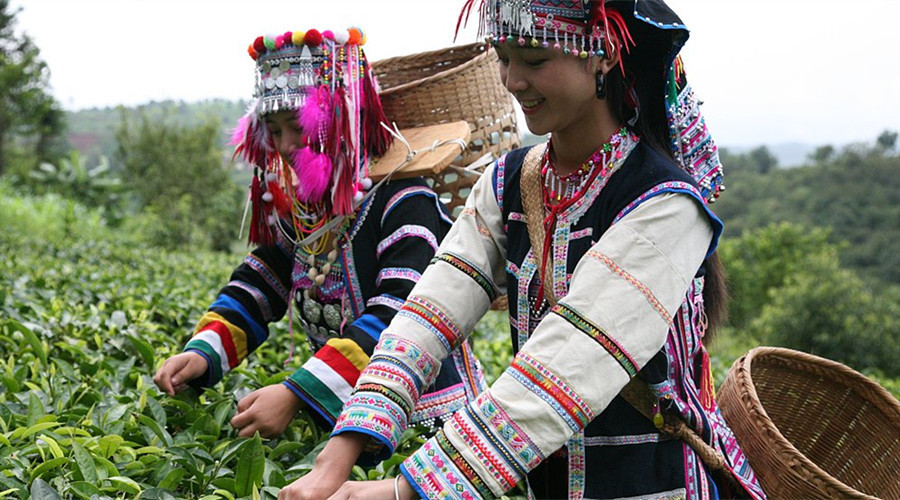
Where to Stay in Simao District
Simao District is a district under the jurisdiction of Pu’er Prefecture, Yunnan Province, China. It is the seat of Pu’er Prefecture. There are many hotels around Simao District. Yunnan Exploration will provide the best hotels for you. The recommended hotels as follows:
| English Name | Chinese Name | Address | Telephone |
| Pu’er Simao Shiping Hall – Tea Horse Post House | 普洱思茅石屏会馆-茶马驿栈 | No. 34 Shuncheng Street, Near Xima River Park, Simao District | 0879-8256999 |
| Pu’er Simao Early Winter Warm Sun Holiday Apartment | 普洱思茅初冬暖阳度假公寓 | No. 18 Ning’er Avenue, Simao District | 021-80187829-168610 |
| Pu’er Little Panda Manor | 普洱小熊猫庄园 | 37 kilometers southeast from Downtown of Simao | 0879-3037000 |
| Pu’er Peony Holiday Inn | 普洱牡丹假日酒店 | No. 7 Shilong Road, Simao District | 0879-3025666 |
| Home Inn (Century Square, Renmin Middle Road) | 如家快捷酒店(普洱人民中路世纪广场店) | No. 6 Renmin Middle Road, Simao District | 0879-2885111 |
| Pu’er Hengrun Hotel | 普洱恒润大酒店 | No. 18 Pu’er Road, District | 0879-2208888 |
| Pu’er Jinglan Hotel | 普洱景兰大酒店
|
No. 68 Zhenxing Avenue, Simao District | 0879-2161066 |
| Pu’er Mancheng Business Hotels | 普洱曼城商务酒店 | No. 46, Chacheng Avenue, Simao District | 0879-3033111,
3033777 |
| Pu’er Yazhi·Yue Boutique Hotel | 普洱雅致·悦精品酒店
|
No. 666 Linyuan Road, Simao District | 0879-8806888, 8806999 |
| Pu’er Manlin Hotel | 普洱曼林酒店 | Nanping Road, opposite to New Passenger Transport South Station | 0879-8880091 |

Recommended travel route and duration on each:
Half an hour on Tea Enquiry Tower (Wen Cha Lou) – 20min on Puer Tea Museum – half an hour on the minority villages – 30-40min on Puer Tea Processing Workshop – 20min on Puer Tea Appreciation Garden (Pin Jian Yuan) – 10min on Tea Ancestor Hall (Cha Zu Dian) – Tea House – Relaxation and Enjoyment Zone (Xian Yi Ju).
When you traveling Pu’er, it is a good place to be put on your list. It can be joined in whatever your Pu’er tour or Yunnan Tour.
11 Days Yunnan Ancient Tea-Horse Road Tour with Puer and XishuangBanna Tea Culture Exploration
14 Days Southwest Yunnan Tea Culture Tour from Xishuangbanna to Puer and Lincang
Travel Tips
Best Tea-leaves Picking Season Spring tea leaves in dry season: from end of February to mid May
Rainy season tea leaves: from end of May to end of September
Autumn tea leaves: from end of September to end of November
Note: It is best to pick around half an hour after sunrise.
Where is the Confucian Temple in Jingdong County
Located in the west of Jinping Town of Jingdong County and covering 5,292 square meters, the Confucian Temple stands in front of the Yuping Mountain. The general layout is on a symmetric basis. The Temple stands at the foot of Yuping Hill to ther west of Jingdong county seat, and the temple was constructed in the 21st year (1682) of the Kangxi Reign of the Qing Dynasty and is one of the province-level protected historic relics in Yunnan. With a complex of majestic, quaint and elegant architectures, the temple is one of the best preserved of its kind in the southwest of Yunnan Province.
With its façade facing the east, the temple lies beside waters and mountains. It faces the Ailao Mt in the front and backs on the Wuliang Mt. Stepping into the temple, visitors will be impressed by towering ancient trees and pavilions decorated with glazed tiles and flying eaves.
What to see in Confucian temple?
Woods in the Confucian temple are serene and majestic, just like those in the hometown of Mr. Confucius. The architectures in the temple include Panchi Pool (Panchi, a pool in front of a school in ancient China, thus Panchi refers to school of Confucianism in ancient times), Bell Tower, Lingxing Gate, Dacheng Gate and Dacheng Hall, all artistic, exquisite and classic.
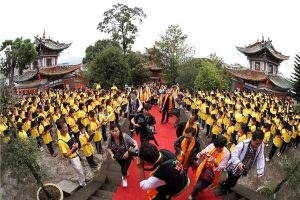
There are in all five courtyards in the temple. The Chuanhe River in its front, Fenghuang Mt in the east, Lingxing Gate, the Jar at the roof of Dacheng Hall, and the peak of Yuping Mt are miraculously at the longitudinal axis, creating majestic views and featuring the traditional Chinese imperial architectural style. The temple is a good example integrating Chinese traditional culture and classic architectural art.
Panchi Lake
There are half-pools, Lingxing Gate(棂星门), Dacheng Hall, and some living rooms in the Temple. One of the half pool is a crescent moon made of stone, which is beautiful and generous. It has a profound cultural heritage. It is said that in the ancient Chinese Spring and Autumn Period, the school of Lu State was called the Pan Palace, and the moon-shaped pool in front of the palace was called Panchi. Confucius was the Lu people. He had taught in Lu, so in order to commemorate this greater, later, when they built the Temple, and they had built a pot. At that time, students entered the school and also called the pool. There are 45 stone pillars and 41 slate stones around the Panchi Lake. There are 6 stone pillars and 5 stone slabs on both sides of the stone arch bridge. When entering the temple, it is necessary to pass the bridge, which means that the stone bridge will pass. Throw away all selfish dissatisfaction, sincere worship, in order to climb the peak, the gold will shine.
Lingxing Gate(棂星门)
The Lingxing Gate is also known as Tian Xing. Whenever worshipping the heavens, first worship the Lingxing Gate and pray for heaven to bless, in order to achieve the goal of harvesting the grain, prospering the six animals, and doing things with ease. Therefore, before respecting the Confucius must respect the heavens, and respect the heaven is to respect the Confucius. It can be seen that the ancient ancestors’ respect for Confucius remained the same in ethnic minority areas in the border areas. The Lingxing Gate is a relatively complex building in the Temple of Confucian. It has the characteristics of oriental architecture. It is a beam-lifting building. It is made up of stalwart boulder. There are various animal which reliefs around it. There are gorgeous arches under the eaves. The whole building is magnificent and magnificent.

Dacheng Hall
Dacheng Hall is the largest building in the Temple of Confucian. It is solemn, and it is exquisite in workmanship. It is 20 meters long and 15 meters wide. There are 28 large cylindrical columns on the drum pier. The temple door is carved wood and carving craft, and nearly 100 kinds of animal flowers are vivid, such as “San Yang Kai Tai”(May you life be auspicious!), “Zhu Bao Ping An”(a family letter reports peace), “Wu Long Bao Shen”, ” Xi Que Nao Mei”(Magpiestake you good luck).”Dacheng” praises the greatness of Confucius. He combines the sages and cultures. “Dacheng is the Holy Master.” He has been highly appraised in history.
The statue of Confucius in the center of Dacheng Hall is made of white marble sculpture, giving a sense of dignity and elegance. Confucius occupies a very important position in the field of creating Confucianism. The emperors of all ages had the “inscription” of praise and respect. For example, the three gold plaques are all from the “Shen Xie Shi Zhong” by Daoguang in the Qing Dynasty, the “De Ji Chou Zai” of Xianfeng, and the “Si Wen Zai Ci” of Guangxu, all of which illustrate the Emperors respect Confucius and Confucianism in the Qing Dynasty.
There are various cultural relics collections in Jingdong County in the two rooms. There is a cultural relic display unearthed from the tomb of the toast, and there is also a historical relic display of Jingdong. It is a solid textbook. It proves the origin of Jingdong culture from one side.
Why must the temple built at the hill foot but not on the flat area?
The answer is that one must climb the steps upwards to eventually get to the Dacheng Hall (the Hall of Achievement), which implies the philosophy that students must try hard in order to finally reach great achievements.
History of Jingdong Comfucian Temple
Jingdong Confucian Temple is located in the center of Jingdong Old Town. It is adjacent to Jingdong No. 1 Middle School, the highest institution in Jingdong. It is the largest Confucius Temple in southwestern Guizhou. It is also called the School of Learning. It was built in the 21st year of Qing Emperor Kangxi (AD 1682) ), with a total area of 5292 square meters, has been repeatedly burned by war and rebuilt several times. The most recent one was rebuilt by the state in 1984. The entire building is a multi-level courtyard building complex. The Temple is backed by the Wuliang Mountain, facing the waters of the Luanchuan River, and the five pilgrimages of the dragons. The natural landscape is very beautiful. Under the backdrop of Gumei, Cangsong and Cypress, it is more poetic and artistic.
How to Get to Jingdong Comfucian Temple
1. By Air
In recent years, the state has increased its investment in infrastructure construction, especially the civil aviation industry, which has created a very good policy environment for the construction of Jingdong Airport. At present, Jingdong Airport is under planning.
2. By Train
Pu’er Railway Station is the middle station of the Yumo Railway under construction and an important station for the Laos section of the Trans-Asian Railway. It is expected to be put into use by 2020.
3. By Long-distance Bus
There is the Passenger Station in Jingdong County for people to get in.
4.Jingdong– Jingdong Comfucian Temple
Take the taxi or rent a car to go to the Jingdong Comfucian Temple.
Where to Stay in Jingdong County
Jingdong County is a county under the jurisdiction of Pu’er City, Yunnan Province, China. There are many hotels around Jingdong County. Yunnan Exploration will provide the best hotels for you. The recommended hotels as follows:
1. Pu’er Jingdong Kaihong Hotel(普洱景东凯宏公寓)
Add: No. 25 Jingchuan Road, Jingdong, Pu’er (普洱景东景川路25号)
Tel: 0879-6226968
2. Lantian Hotel(蓝天酒店)
Add: No. 2 Yuping Road, Jingdong, Pu’er(普洱景东玉屏路2号)
Tel: 0879-6229999
3. Jnifeng Grand Hotel(金丰大酒店)
Add: No. 74 Lingyun Road, Jingdong, Pu’er(普洱景东凌云路74号)
Tel: 0879-6222266
4. Jingdong Huangma Hotel(景东皇马酒店)
Add: No. 36 Lingyun Road, Jingdong(景东凌云路36号)
Tel: 0879-6227266/13628795303
5. Jingdong Jinghao Hotel(景东景豪大酒店)
Add: Next to Jingtai Daqiao, jinping Town, Jingdong(景东 锦屏镇景太大桥旁)
Tel: 0879-3083222
6. Jingdong Nanyanghe Hotel(景东南羊河酒店)
Add: No. 86 Lingyun Road, Jingdong
Tel: 0879-6220933
Best Time to Visit
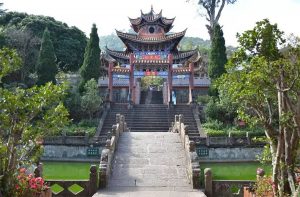
It is suitable to visit Jingdong County all year round. Like many other cities in Yunnan, Jingdong is a place where the seasons are like spring. There is no cold, no heat, warm and humid, especially suitable for human habitation, so you can go to Jingdong at any time.
Recommended Tour
When you traveling Pu’er, Jingdong County is a good place to be put on your list. It can be joined in whatever your Pu’er tour or Yunnan Tour.
11 Days Yunnan Ancient Tea-Horse Road Tour with Puer and XishuangBanna Tea Culture Exploration
14 Days Southwest Yunnan Tea Culture Tour from Xishuangbanna to Puer and Lincang
Travel Tips
1.There are many ethnic minorities living here, such as Lahu, Hani, Wa and Yi. Varied customs make it a colorful city. Eating habits, ceremonies, costumes and folk legends can all be a strong attraction for people who are visiting. In addition, the city is the hometown of the well known Puer Tea, and the local people have diversified ways of handling tea, such as bamboo tube tea, cold tea dish, earth-pot tea and baked tea; all of which you should try.
2.Enjoying a plateau monsoon climate at low latitude, the region is affected by the Indian Ocean and the Bay of Bengal. Therefore, the main features of its weather are mildness and humidity without strong winds.
3.Special Local Products: Puer Tea, bamboo shoot, edible fungi, purple rice, mango.
Lushi Ancient Town
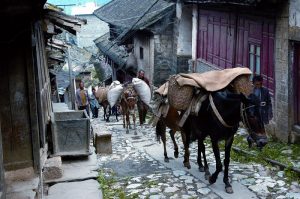
As the most important town of the Ancient Tea Horse Caravan Road in the past, Lushi Ancient Town is situated in the northeast of Fengqing County, about 84 km from the county seat. With a population of more than 2,300, Lushi is the co-inhabited by nationalities such as Chinese Han, Yi, Miao and Bai etc, among whom Yi is the “aboriginals”. Lushi Ancient Town is known for its long history and profound culture. The street was expanded a lot because of the contacting caravans. The local architectures were influenced by the traditional residences of Bai ethnic minority and Nanzhao Kingdom. Lushi Ancient Town is the important place for the discovery of Ancient Tea and Horse Caravan Road.
Why is Lushi Ancient Town so special?
As the first town of western Tea and Horse Caravan Road, Lushi Ancient Town is one of the top three mysterious ancient towns. Lushi Ancient Town is known for its long history and profound culture. It has been listed into the book “Chinese Famous Old Towns” as one of the “100 Chinese Old Towns”.
2002, Provincial Key Protection Unit
2006, Provincial Historical and Cultural Town
2012, one of the 201 featured towns in China
2013, National Cultural Relics Protection Unit
How to get to Lushi Ancient Town?
Lushi Ancient Town is 82 km from the county seat of Fengqing County. Travelers can drive for 150 minutes to Lushi Town. Most parts of the road to Lushi are asphalt roads. It enjoys the good condition.
Introduction os Lushi Ancient Town
History of Lushi Ancient Town
Lushi Old Town is known for its long history and profound culture. It has been listed into the book “Chinese Famous Old Towns” as one of the “100 Chinese Old Towns”. In the ethnic language of the Yi People, “Ah Lu” means “a small town”. In 1598, an “Ah Lu Si” (governmental office) was established. When it came to the Republic of China (1911-1949), “Ah Lu Si” had been renamed into “Lu Shi” which remains the same till today. There is an ancient passage in Lushi Old Town that came into being in the early 14th century. The passage used to serve as the linkage between the inland of China and the frontier areas in Southwest Yunnan. To the north, it can connect Kunming Area while to the south it is a passage for access into Myanmar and the Southeast Asian Countries via Shunning and Zhenkang. In the Tang and Song dynasties, Lushi was an important part of the South Silk Road and had developed into a dak on the Ancient Tea-Horses Trail (Road) in the Qing Dynasty and the Republic of China.
Trade on the Ancient Tea and Horse Road
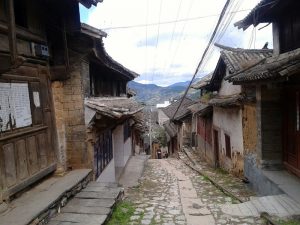
Lushi Town, because of the history of the Ming and Qing Dynasties before the opening of Myanmar, Thailand commerce and the ancient Silk Road, is ideal for business. The reason for regime change and war, the mainland officials, tycoons, businessmen, artisans constant movement frontier, in the light of the history of Lu climate and environment in the strategic advantages, they then choose to settle here. Mainland people Laji bring advanced technology and social civilization, and promoting the history of Lu local construction, textile, food and handicrafts and the development of religious, cultural prosperity.
Lushi Town, 800 meters long, 538 meters wide north-south, with a total area of 430,000 square meters. The Lancang River and Lu Shun Ningfu a history of the town at two halves, the history of the Mainland officials to send flow Shun Ning, or all-Zhuguan to the Mainland, can only rely on Mang Kaito, rhino from the ferry crossing. Qing Emperor Qianlong 26 (1761) Governor Liu Jing Shun Ning Zhifu soil in the construction of Tsing Lung Bridge Akiko found that Kinmen and Matsu on the Lancang River at the foot of the mountain, this is the first grand Shun Ning Qing Dynasty architecture, but also in the Lancang River has three Old Bridge still preserved the only steel bridge.
Tsing Lung Bridge, upon completion, traffic has been further development, and promoted Lu to the prosperity of the local economy. Silk fabric foreign yarn, cotton cloth, salt and other products and the local tea, walnut, fungus and other native products were sent to the distribution center for the transaction.
Main Routes Passing Tea and Horse Caravan Road
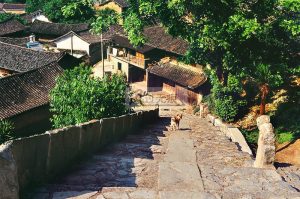
There are three main lines of Tea-Horse Trade Caravan Road from Lincang City:
1. Fengqing (Shun Ning) – Lu shi – Weishan – Shimonoseki – Lijiang – Zhongdian – Tibet
2. Fengqing (Shun Ning) – Lu shi- Shimonoseki – Kunming – Foreign;
3. Dali – Shimonoseki – Weishan – Lu History – Feng Qing (Shun Ning) – Hong town – Gengma – Myanmar.
What to See
Located in the northeast of Fengqing County, Lushi, called as the Alusi beafore, evolved from the history of indigenous ethnic languages. Lushi Ancient Town is one of the ancient buildings with relatively preservation and large scale in western Yunnan. Generally speaking, the layout of the street and the style of construction of the houses have strong religious and cultural characteristics. Enjoying the long and profound history, the caravans frequented the town for business. The expanding street formed a unique layout, with Sifang Streer as the center.
The residential building is mainly based on the courtyard of the north of China and the style of the south of Yangtze River. Influenced by diverse architectures, most houses enjoy the courtyard, garden and many traditional decorations like couplet and poems.
Recommended Tours
Accommodation
Lushi Ancient Town is a well-preserved ancient town, without a large-scale and complete commercial tourism. There are no luxury and star-level hotels. You can live in a hostel or farmhouse in the ancient town. The price is relatively cheap, and the local residents are very enthusiastic.You can also return to Fengqing County for accommodation.
Useful Travel Tips
Please respect local custom of the ethnic minorities.
Please protect the environment and the old architectures.
If you want to stay in high-quality hotels, please get back to Fengqing County or Lincang City.
Guangnan Confucius Temple in Wenshan
Why is Guangnan Confucius Temple So Special? Guangnan Confucius Temple广南文庙 was built in 1709(the 48th year of Kangxi period康熙年间 in Qing Dynasty) as a place for worshiping Confucius in...
Najiaying Mosque in Tonghai County, Yuxi
About Nagu Hui Ethnic Town Nagu Hui Ethnic Town is located in the northwest of Tonghai County, backed by the Shizi(Lion) Mountain, facing Qilu Lake(杞麓湖), 14 kilometers from the...
Chengzhai Village of Donggan Town in Malipo County, Wenshan
About Chengzhai Village and Bailuo Ethnic People Located in the Donggan Town of Malipo County in Wenshan, 134 kilometers from the county seat of Malipo County, Chengzhai Village城寨村 is...
Air Corridor of Wangtianshu Scenic Area in Mengla County, XishuangBanna
China’s Sanchahe Nature Reserve in Mengla County, Yunnan Province, is located in a tropical rain forest corridor that stretches from China into neighboring Burma and Laos. Sanchahe Nature Reserve...
Dayingjiang River in Dehong
Why is Dayingjiang River So Special Beautiful Dayingjiang River runs through Yingjiang County in west Yunnan border area. The river mouth is open and its surface is as flat...
Yunnan Red Wine Villa in Mile County, Honghe
Chinese Name:云南弥勒红酒庄 English Name: Yunnan Red Wine Villa in Mile County, Honghe Yunnan Red Wine Villa, which is a national agricultural demonstration site, is located beside the Kunming-Hekou Highway, 14...
The Ancient Wells in Jianshui County, Honghe
Chinese Name:建水古井 Engish Name: The Ancient Wells in Jianshui County, Honghe Dozens of ancient wells scatter in the ancient town of Jianshui, Honghe Prefecture. Some of them are single-mouthed, double-mouthed,...
Moli Waterfall in Ruili City, Dehong
Why is Moli Waterfall So Special Moli Waterfall, also known as Zhaduo Waterfall, is located in the Moli Canyon in the junction of Mangshi, Luanchuan and Ruili. It is hidden...
Nandian Xuanfu Chieftain Office in Lianghe County, Dehong
Why is Nandian Xuanfu Chieftain Office So Special Built in the first year of the emperor Xianfeng of Qing Dynasty in 1851, Nandian Xuanfu Chieftain Office is located at...
China Puer Tea Exhibition Garden in Puer City
An Overview about China Puer Tea Exhibition Garden Puer tea is the signature tea of Yunnan Province. If you love tasting this tea with fullness of flavor, it is suggested...
The Confucius Temple in Jingdong County, Puer
Where is the Confucian Temple in Jingdong County Located in the west of Jinping Town of Jingdong County and covering 5,292 square meters, the Confucian Temple stands in front...
Lushi Old Town in Fengqing County, Lincang
Lushi Ancient Town As the most important town of the Ancient Tea Horse Caravan Road in the past, Lushi Ancient Town is situated in the northeast of Fengqing County, about...
Tips Before Travel
Bring copies of your passport
Don't assume you're restricted to the main hubs of Beijing and Shanghai, our tours can start from any city.
Register with your embassy
For your safety, please register with the Embassy.
Always have local cash
Exchange some local currency for your trip
Our Team
Customize a Trip
Start planning your tailor-made holiday to China by contacting one of our specialists. Once enquired, you’ll get a response within 0.5~23.5 hours.























